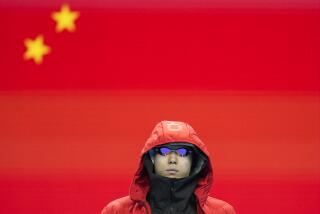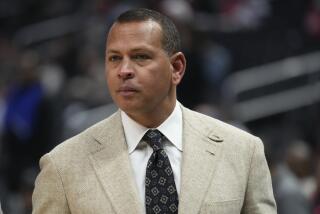‘Intentional Doping of the Worst Sort’ Found Among U.S. Track Athletes
- Share via
United States anti-doping authorities said Thursday they had uncovered widespread use by track and field athletes this summer of a new and previously undetected designer steroid, linking its development and distribution to a Bay Area nutritional supplement laboratory already under investigation by a federal grand jury in San Francisco.
The U.S. Anti-Doping Agency, which oversees drug testing for all sports federations under the U.S. Olympic umbrella, said an anonymous tipster who provided a sample of a steroid called tetrahydrogestrinone, or THG, identified Victor Conte, founder of Bay Area Laboratory Co-Operative, or BALCO, as the source of the new drug.
The investigation began in June and has been expanded to some professional sports, said Terry Madden, chief executive of the USADA.
After developing tests to detect THG, the drug agency authorized retesting of about 550 urine samples, resulting in an unknown number of positive tests. The athletes who tested positive, who were unnamed, could face suspensions that would keep them from competing in the 2004 Athens Olympics.
Madden declined to provide specific numbers but said, “I know of no other drug bust that is larger than this involving the number of athletes involved. What we have uncovered appears to be intentional doping of the worst sort.
“This is a far cry from athletes accidentally testing positive as a result of taking contaminated nutritional supplements. Rather, this is a conspiracy involving chemists, coaches and certain athletes using what they developed to be ‘undetectable’ designer steroids to defraud their fellow competitors and the American and world public who pay to attend sporting events.”
Conte, responding in an e-mail to several Bay Area newspapers, disputed the agency’s findings.
“In my opinion, this is about jealous competitive coaches and athletes that all have a history of promoting and using performance-enhancing agents being completely hypocritical in their actions,” Conte said in the e-mail. “As many will soon find out, the world of track and field is a very dirty business and this goes far beyond the coaches and athletes.”
Conte is a self-described nutritionist, and his company provides blood-testing services for many top athletes, including baseball star Barry Bonds of the San Francisco Giants and Olympic sprint champion Marion Jones.
Agents from the Internal Revenue Service, the Food and Drug Administration, the San Mateo County Narcotics Task Force and Olympic drug testing officials raided the Burlingame offices of BALCO on Sept. 3. Two days later, agents searched the home of Greg Anderson, personal trainer for Bonds.
Conte said in Thursday’s e-mail that THG is not an anabolic steroid and added that it is not a controlled substance or banned by any sports governing body.
“There is not a single shred of scientific information published on this substance,” he said. “Just because it may be structurally similar does not mean that it has anabolic effects.”
The USADA’s Madden said THG’s chemical structure is similar to the banned anabolic steroids gestrinome and trenbolone. THG is not on a list of banned substances in track and field but would be a related substance outlawed under the sport’s anti-doping rules.
“This is a serious warning for cheaters,” said Dick Pound, chairman of the World Anti-Doping Agency. “It shows that supposedly undetectable substances can be detected as new tests are developed.”
USA Track & Field said in a statement issued Thursday that it “lauded” the USADA’s work, adding that “all those responsible for drugs in sports, including supplement laboratories, chemists, coaches and athletes, should be held accountable for their actions.”
The USADA was created three years ago, in large part because of concerns that the U.S. Olympic Committee could not properly oversee drug testing. USOC spokesman Darryl Seibel said Thursday’s announcement showed the wisdom of outsourcing U.S. anti-doping policies to an independent agency.
“We created USADA to be a leader in the fight against doping in Olympic sport,” he said. “There is no issue of greater importance to the USOC and the Olympic movement, and their effort underscores the commitment we’ve made.”
Anabolic steroids are derivatives of the male hormone testosterone that help build muscles by altering hormone balances.
Because of steroids’ performance-enhancing qualities, most sports federations ban their use and enforce that ban through drug testing. The tests measure the compounds of drugs by their molecular weight. Adjusting the molecular structure makes the “new” steroids undetectable until the substance is identified independently.
The USADA said it first learned of what it later identified as THG in early June, when someone it referred to only as a “high-profile track and field coach” telephoned the agency to provide the names of U.S. and international athletes using an undetectable new drug.
The coach sent the USADA a used syringe that contained some of the substance. How he came to possess it or from whom he received it were not immediately clear. The substance was turned over to Dr. Don Catlin, head of an International Olympic Committee-accredited laboratory at UCLA.
After two months of examination, Catlin’s team of scientists determined that the chemical properties of the new drug were found to be similar to those of banned steroids.
“For us, it was a needle in a haystack,” Catlin said. “It took massive man-hours. These are not simple tasks. It took two months to figure out what it was, and that’s eight people working very hard. And we’re not inexperienced.”
Catlin’s lab then developed a test to detect the new drug in urine samples.
About 350 samples from the U.S. Track and Field Championships in June, 100 random, out-of-competition samples from track athletes, and 100 samples from other Olympic sports were retested, resulting in an unknown number of positive tests.
Olympic and would-be Olympic athletes are tested regularly at major competitions for steroids, stimulants and other banned substances. They also face random testing between events. Each sample is divided into two and stored for testing and reference.
For the athletes who tested positive, USATF, the International Assn. of Athletics Federation and the USOC each have been notified of the positive “A” samples.
The next step is for the “B” samples to be tested, and if those also are positive, a review and appeals process begins. Suspensions for steroid use usually result in two-year bans, which would force the athletes to miss the Athens Olympics in August.
Conte was perhaps previously best known for his role as a defender of shot-putter C.J. Hunter at the 2000 Sydney Olympics. Hunter, who was married to Jones at the time, pulled out of the competition because of a knee injury, but while in Sydney it was disclosed that he had failed four drug tests for steroid use during the summer.
Conte said the positive tests were caused by iron supplements Hunter was taking in advance of the Olympics. Conte did not identify the supplement.
A review of the 350 samples from the June U.S. track championships, meantime, also led officials to discover several positive tests for the stimulant modafinil. Sprinter Kelli White, who tested positive for the drug at the World Championships this summer after winning the 100- and 200-meter events, has claimed she was taking it for narcolepsy, a sleep disorder.
With the announcement that the USADA’s investigation has been expanded to other professional sports, a high-ranking baseball official referred to articles on BALCO and said:
“We’re aware of the situation and are watching it. From what we understand the focus is on the company and product. If and when it comes to us, we’ll decide on how to handle it. There’s no sense in us, as a third party, poking our nose into it until we know what direction the government is going, if, in fact, the government decides on a direction.”
All of major league baseball’s drug rules are established in collective bargaining with its powerful players union. Steroid testing is being conducted for the first time as part of the new labor agreement, which was implemented this season. Under the system, each player was tested once and tested again five days later. Later, 240 players were selected randomly to be tested again at a later date, and tested again five days later.
Baseball couldn’t retest now even if presented with conclusive evidence that there was a new steroid on the market. The list of banned steroids is agreed to by baseball and the union. It can be revised each year but not during the year.
*
Times staff writers Helene Elliott and Ross Newhan contributed to this report.
More to Read
Go beyond the scoreboard
Get the latest on L.A.'s teams in the daily Sports Report newsletter.
You may occasionally receive promotional content from the Los Angeles Times.






